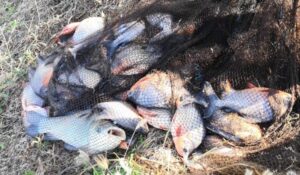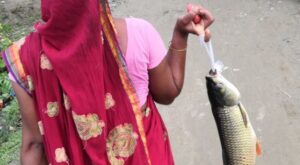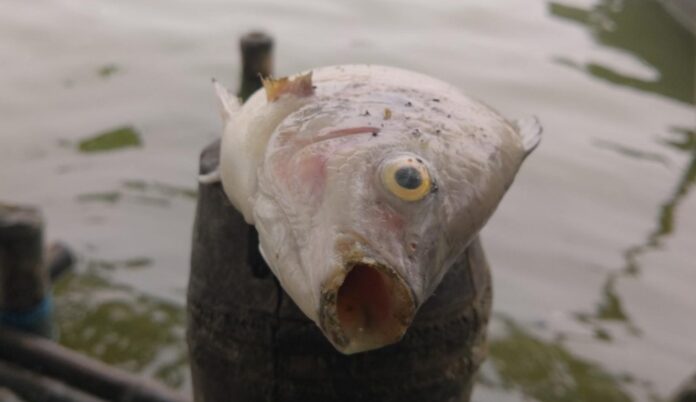The total production from fisheries in India has increased by 14.33 percent between 2018 and 2019, with Indian Major Carps (IMCs) (Catla, Mrigal and Rohu) from inland aquaculture contributing to 58.55 percent of the total fisheries production in 2018, according to Food and Agriculture Organisation of the United Nations. India currently stands second in the world in terms of production of fishes from aquaculture, only behind China. These are some big numbers that surely form a big chunk of the GDP of India. Being a mammoth sized sector with the lack of rigorous regulatory framework, aquaculture results in suffering to a large number of animals, which are never even considered as sentient beings.
A recent investigation undertaken by FIAPO across 241 aquaculture farms (161 freshwater and 80 brackish water) across nine states and one union territory in India, revealed that in Dissolved Oxygen in both freshwater and brackish farms was found to be consistently below acceptable levels in almost all states. The presence of heavy metals such as lead and cadmium were found at hazardous levels in all samples. It also revealed that antibiotics were widely used to prevent the incidence of diseases and stocking density was extremely high in freshwater farms that were raising catfish and pangasius.
The report stated that the situation was the similar in shrimp farms but since majority of the shrimp produced is exported, shrimp farms had good potential to self-regulate the water quality. Other factors contributing to this were involvement of wealthy entrepreneurs who can afford basic and advanced requirements of shrimp farming, strict regulations imposed by EU, Japan, US and other countries importing shrimp from India.
The states where investigation was done include Tamil Nadu, West Bengal, Bihar, Andhra Pradesh, Jharkhand, Gujarat, Odisha, Assam and Chhattisgarh, besides the union territory of Puducherry.
Cruelty in Fisheries
FIAPO report also highlighted the cruelty in these farms as fishes and shrimp are dragged on to the land by drag netting in over 95% of the farms and were killed by asphyxiation in air. In some cases “such as catfish (and occasionally carps), the animals are transported live to fish markets and killed when they are ‘warm’ according to customers’ preference by cutting the fishes through their gills to bleed them out without any stunning. The shrimp are placed in crates on ice while they are fully conscious and are transported alive to processing facilities which are predominantly export-focused.”



According to a Liverpool University, fish experience pain as they have ‘nociceptors’ (cells that detect pain) in their mouths. It just shows the need for more stringent fish welfare laws in the country.
During the investigation, FIAPO also found that over 95% of the farmers do not check their ponds for the important water quality parameters even once in a week. Most farmers feel that fish feel stressed and that it negatively affects their wellbeing, although they didn’t use the word ‘pain’ when asked about the ability of the fishes to feel pain. Almost all of them used the word ‘stress’ instead of ‘pain.’ Some farmers went on to furnish factors that could induce ‘stress’ such as high stocking density and poor water quality.
FIAPO says, “Fishes suffer excruciatingly when hauled on to the surface where they are killed by asphyxiation in air. This is standard operating procedure for killing fishes currently in almost all parts of the world. Imagine seeing a butcher drowning a chicken or a pig in water to kill the animal. There would be widespread outrage for doing that, although the animal is going to be killed, due to the torturous nature of drowning. But no one bats an eye, heck, people even enjoy when fish are asphyxiated in air (which is similar to drowning a terrestrial animal).”
Public and Environment Health Hazard
FAIPO investigation found that there is a tendency amongst farmers to administer antimicrobial and growth promoters to fish and shrimps, thereby creating a serious public health hazard in the form of antimicrobial resistance (AMR), which has been declared by UN as global health emergency. AMR is already a cause of concern as a result of mindless use of antibiotics in animal agriculture. With aquaculture being added to it, it will end up becoming nothing less than a catastrophe.



Some farmers in Andhra Pradesh, Gujarat and Assam admitted that they frequently sold diseased shrimps in the local markets rather than sending it for export as they fail to meet stringent regulations. All water samples showed “hazardous levels of Lead and Cadmium in the farms and effluent water. This poses a grave threat to public health as this water is directly discharged into the nearby canals and estuaries leading to the rivers.”
Turbid water and algal cover was observed at many sites. Other key environmental concerns include encroachment on adjoining agricultural farms and mangrove forests, as well as increased salinity in nearby water sources.
(All Images Courtesy: FIAPO)


